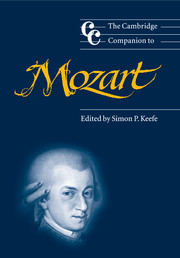Book contents
- Frontmatter
- Introduction
- Part I Mozart in context
- 1 Mozart and Salzburg
- 2 Mozart in Vienna
- 3 Mozart's compositional methods: writing for his singers
- 4 Mozart and late eighteenth-century aesthetics
- Part II The works
- Part III Reception
- Part IV Performance
- Notes
- Selected further reading
- General index
- Index of Mozart’s works
4 - Mozart and late eighteenth-century aesthetics
from Part I - Mozart in context
Published online by Cambridge University Press: 28 September 2011
- Frontmatter
- Introduction
- Part I Mozart in context
- 1 Mozart and Salzburg
- 2 Mozart in Vienna
- 3 Mozart's compositional methods: writing for his singers
- 4 Mozart and late eighteenth-century aesthetics
- Part II The works
- Part III Reception
- Part IV Performance
- Notes
- Selected further reading
- General index
- Index of Mozart’s works
Summary
Mozart was keenly aware of and interested in the views of his contemporaries on matters of aesthetics, but curiously it has taken almost two centuries for us to recognize this fact and to realize how critical some of this thinking may have been in influencing him as a composer. The reasons for this hiatus are not entirely straightforward, but emerge in part in the vast literature on Mozart prior to the final decades of the twentieth century. One of the simpler possibilities appears to be that writers on music in general or Mozart in particular rarely had much interest in fields other than music, and in any event often preferred to treat music as a self-contained entity, relatively free from the influence of other disciplines. The prevailing view of Mozart emerged in the late nineteenth and early twentieth centuries when the focus lay on his genius – a peculiar notion of genius shaped by early nineteenth-century Romanticism and fostered by giants of German philosophy later in the century, including Hegel, Schopenhauer and Nietzsche. For some, Mozart's genius had to be demonically inspired, while for others that genius placed him as an eternal child figure, living in a childlike dream realm detached from reality and, of course, blissfully devoid of education. Writing in the middle of the twentieth century, Alfred Einstein believed Mozart was ‘a child and always remained one’, and even as late as 1971 Michael Levey continued to support a modification of the Mozart-as-child phenomenon, suggesting that ‘what has often been described as the childlike quality which he retained into adulthood was in fact a retention of energy: pure, unhindered and of almost explosive force’.
- Type
- Chapter
- Information
- The Cambridge Companion to Mozart , pp. 48 - 58Publisher: Cambridge University PressPrint publication year: 2003
- 1
- Cited by



